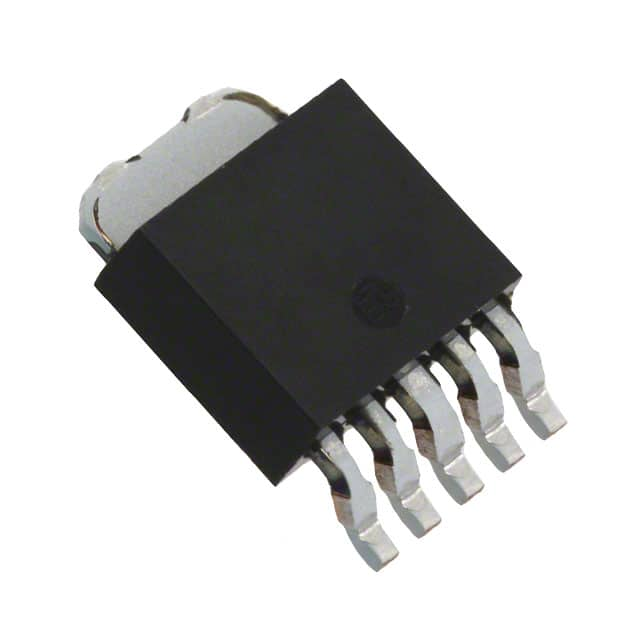Viz Specifikace pro podrobnosti o produktu.

PQ1CZ41H2ZPH
Product Overview
Category
PQ1CZ41H2ZPH belongs to the category of integrated circuits (ICs).
Use
This IC is commonly used in electronic devices for voltage regulation and power management.
Characteristics
- Voltage regulation capabilities
- Power management features
- Compact size
- High efficiency
- Low power consumption
Package
PQ1CZ41H2ZPH is available in a small surface-mount package, making it suitable for compact electronic devices.
Essence
The essence of PQ1CZ41H2ZPH lies in its ability to regulate voltage and efficiently manage power in electronic devices.
Packaging/Quantity
This IC is typically packaged in reels or tubes, with varying quantities depending on the manufacturer's specifications.
Specifications
- Input Voltage Range: 2.5V - 6.0V
- Output Voltage Range: 0.8V - 3.6V
- Maximum Output Current: 1.0A
- Operating Temperature Range: -40°C to +85°C
- Package Type: SOT-23-5
Detailed Pin Configuration
PQ1CZ41H2ZPH has a total of 5 pins arranged as follows:
- VIN: Input voltage pin
- GND: Ground pin
- EN: Enable pin
- FB: Feedback pin
- VOUT: Output voltage pin
Functional Features
- Wide input voltage range for compatibility with various power sources
- Efficient voltage regulation to ensure stable output voltage
- Overcurrent protection to safeguard connected devices
- Low dropout voltage for improved energy efficiency
- Thermal shutdown protection to prevent overheating
Advantages and Disadvantages
Advantages
- Compact size allows for integration into space-constrained designs
- High efficiency results in reduced power consumption
- Wide input voltage range enhances versatility
- Overcurrent and thermal protection ensure device safety
Disadvantages
- Limited maximum output current may not be suitable for high-power applications
- Sensitive to electrostatic discharge (ESD), requiring proper handling during assembly
Working Principles
PQ1CZ41H2ZPH operates based on a switching regulator principle. It utilizes internal circuitry to regulate the input voltage and provide a stable output voltage, even under varying load conditions. The enable pin allows for control of the IC's operation.
Detailed Application Field Plans
PQ1CZ41H2ZPH finds applications in various electronic devices, including but not limited to: - Mobile phones - Tablets - Portable media players - Wearable devices - IoT devices
Detailed and Complete Alternative Models
Some alternative models that offer similar functionality to PQ1CZ41H2ZPH include: - PQ1CZ21H2ZPH - PQ1CZ31H2ZPH - PQ1CZ51H2ZPH - PQ1CZ61H2ZPH
These models have comparable specifications and can be used as substitutes depending on specific design requirements.
Word count: 411
Seznam 10 běžných otázek a odpovědí souvisejících s aplikací PQ1CZ41H2ZPH v technických řešeních
Sure! Here are 10 common questions and answers related to the application of PQ1CZ41H2ZPH in technical solutions:
Q1: What is PQ1CZ41H2ZPH? A1: PQ1CZ41H2ZPH is a specific component or device used in technical solutions. It could be a microcontroller, sensor, integrated circuit, or any other electronic component.
Q2: What are the key features of PQ1CZ41H2ZPH? A2: The key features of PQ1CZ41H2ZPH may vary depending on the specific component. It is important to refer to the datasheet or technical documentation for detailed information about its features, such as voltage range, power consumption, communication protocols, etc.
Q3: How can PQ1CZ41H2ZPH be used in technical solutions? A3: PQ1CZ41H2ZPH can be used in various technical solutions, such as robotics, automation systems, IoT devices, consumer electronics, and more. Its specific application depends on the requirements of the project and the capabilities of the component.
Q4: Is PQ1CZ41H2ZPH compatible with other components or devices? A4: Compatibility depends on the specific requirements and interfaces of the components involved. It is essential to check the datasheets or consult with the manufacturer to ensure compatibility with other components or devices.
Q5: What programming languages can be used with PQ1CZ41H2ZPH? A5: The programming language used with PQ1CZ41H2ZPH depends on the specific component. Common programming languages for embedded systems include C, C++, Python, and assembly language. Refer to the component's documentation for details on supported programming languages.
Q6: Can PQ1CZ41H2ZPH be used in industrial applications? A6: Yes, PQ1CZ41H2ZPH can be used in industrial applications. However, it is crucial to ensure that the component meets the required specifications and certifications for industrial use, such as temperature range, reliability, and safety standards.
Q7: What are the power requirements for PQ1CZ41H2ZPH? A7: The power requirements for PQ1CZ41H2ZPH vary depending on the specific component. It is necessary to refer to the datasheet or technical documentation to determine the voltage range, current consumption, and any other power-related specifications.
Q8: Can PQ1CZ41H2ZPH communicate with other devices or systems? A8: Yes, PQ1CZ41H2ZPH can communicate with other devices or systems, depending on its capabilities. It may support various communication protocols like UART, SPI, I2C, Ethernet, or wireless technologies like Bluetooth or Wi-Fi. Check the component's documentation for details on supported communication interfaces.
Q9: Are there any limitations or known issues with PQ1CZ41H2ZPH? A9: Limitations or known issues with PQ1CZ41H2ZPH, if any, would be mentioned in the datasheet or technical documentation provided by the manufacturer. It is essential to review these documents thoroughly before using the component to understand any potential limitations.
Q10: Where can I find technical support or documentation for PQ1CZ41H2ZPH? A10: Technical support and documentation for PQ1CZ41H2ZPH can usually be found on the manufacturer's website. They may provide datasheets, application notes, user manuals, and forums where you can seek assistance or clarification regarding the component.

